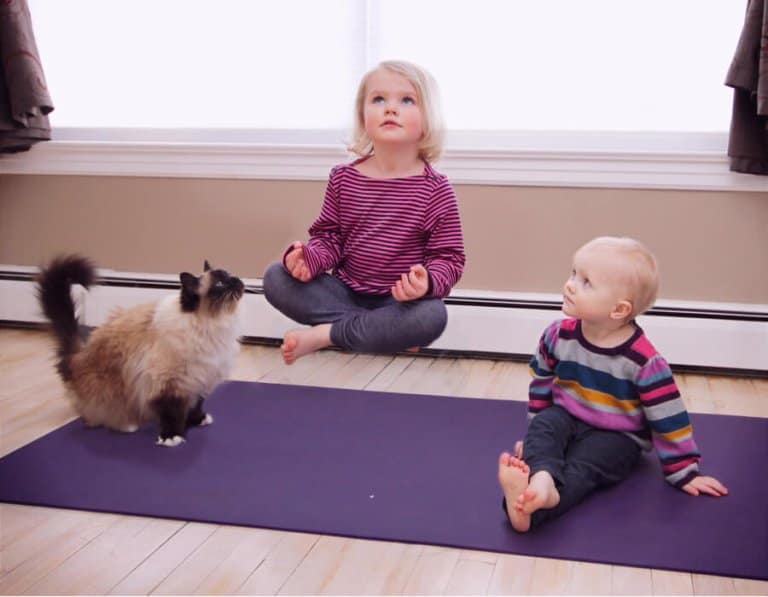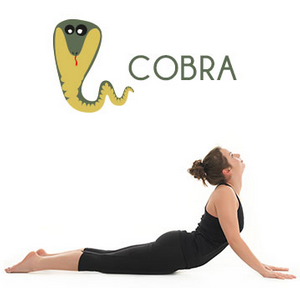Integrating Kids Yoga into Your Homeschool

Yoga is a system of exercises that helps to improve overall health and wellbeing by building strength, flexibility, and awareness in both mind and body. Breath work, physical postures or asanas, and simple meditation are practiced by people of all ages and in many different states of health and levels of fitness.
Yoga practitioners have long attested to the numerous benefits of yoga including better posture and body alignment, increased focus and concentration, stress relief, and much more.
Can children benefit from the practice of yoga as well?
Definitely!
Yoga is certainly a unique and exciting way for children to develop physical, mental, and socio-emotional skills through the use of poses, games, songs, and stories that can easily be incorporated into their daily lessons or academic concepts. All it takes is a little bit of creativity and an open mind!
Here are some of the benefits of yoga for kids:
- Improves physical strength (including gross and fine motor skills)
- Improves flexibility and posture
- Increases emotional strength
- Nourishes creativity
- Develops focus and concentration
- Develops coordination and balance
- Encourages cooperation and teamwork
- Helps in regulating emotions
- Expands awareness of nature, animals, and the environment
- Improves overall health and well-being
Incorporating Yoga Into Your Homeschool
You can easily bring these healthy benefits of yoga to your homeschooling curriculum, daily lessons, or afterschool activities with these fun yoga ideas.
Introduce a New Theme or Concept Through Yoga Poses
If your theme is all about animals, you can try doing animal yoga poses and make animal sounds that the children can imitate. This helps children learn to make associations and connections between the name of the animal, how it looks like, what sound it makes, what it does, or where it lives.
This also fosters creativity and imagination as children learn to create their own poses. You can reinforce this concept by doing concrete activities such as visiting a zoo. Then you can practice more poses at home based on the zoo animals you saw!
A Yoga Journey
Another way to introduce a concept is through a Yoga Journey. This is a perfect complement in teaching History or Geography. You can prepare flash cards of images of places you are planning to “go on a journey to.”
For example, if you are going to ancient Egypt, prepare some photos of pyramids, camels, or a sphinx to familiarize the children with the class content. Then you can invent yoga poses based on your pictures. You can also include games, stories, songs, and dance movements.
The possibilities are endless!
Two Examples of Sphinx Pose


Image source: http://mag.activewearusa.com/yoga-fun-kids-moms/ and https://www.artofliving.org/in-en/yoga/yoga-poses/salamba-bhujangasana-sphinx
Practice Rote Counting During Yoga
One unique and engaging way to practice rote counting is to do it while holding a yoga pose. This way, kids get to improve their balance and practice a math skill at the same time!

Image source: http://www.kidsyogastories.com/circus-yoga/
For example, children can do the tree pose (pictured above) while counting from one to ten. Use a variety of poses to help improve their focus and concentration.
Introducing Basic Patterns
Introduce the concept of basic patterns through a yoga game called “Follow My Body.” It’s a simple but fun and efficient game. All you need to do is clap a certain rhythm, and the kids respond with the same.
Be creative and combine other body movements such as stomping the feet or tapping a particular body part. Here’s a simple example you can start with:
Clap, clap, clap, stomp, stomp, stomp.
Clap, clap, clap, stomp, stomp, stomp
Clap, clap, clap, stomp, stomp, stomp
Clap and tap (your hands to your lap)
Clap and tap (your hands to your lap)
Clap and tap (your hands to your lap)
Acting Out Story Books
Read and act out kids’ story books. Brighten up story time by using yoga poses to act out the scenes in your story.
Choose an age-appropriate book that has lots of animals or objects featured in it and make it into a whole yoga class. As you read the story, do some poses to imitate the animals or objects in the book.
Check for understanding and retention by asking the kids to do the poses again with you! Yoga storytime is a great way to encourage physical movement, enhance language and vocabulary skills, improve listening skills, and comprehension.
Toe-ga for Sorting, Counting, and Color Recognition
We all love games! Teach color recognition, sorting, and counting through a fun yoga game called Toe-ga! This simple game is a crowd favorite.
All you need are various colored pom-poms. Put a bunch of pom-poms on the floor, scattering them a bit. Instruct the kids to keep their hands behind their backs. Demonstrate to them how to use their feet to grab one pom-pom and transfer it to the other side of the floor.
This game helps children develop balance, focus, and coordination. At the same time, they get to learn math concepts in a fun way. One variation you can do is to instruct the children to get a specific color of pom-pom only. The children can then count the pom-poms they have collected. You can also do skip counting!
 Image source: http://kiddingaroundyoga.com/blog/author/laurenbrown/
Image source: http://kiddingaroundyoga.com/blog/author/laurenbrown/
Wrapping Up
There are so many ways to incorporate kids’ yoga in your homeschool. You can use yoga as a tool to teach anything from animals to geography to stars and planets! Just be creative and resourceful! Combine other elements such as music and movement, arts and crafts, or using toys and props.
The most important thing to remember when incorporating yoga for kids into your homeschool is to always keep it fun, open, engaging, and simple.
Since yoga provides many poses that are appealing to kids’ interests and learning, kids yoga can easily and efficiently be integrated into the curriculum. Remember to focus on what yoga can bring to your homeschool and your family.
There’s no need to worry about not being able to get into the pose accurately. Just keep in mind your intention or goals for your practice. May it be for relaxation, for learning an academic concept, or for physical strength.
Let those goals guide your practice. Have fun!







Leave a Reply